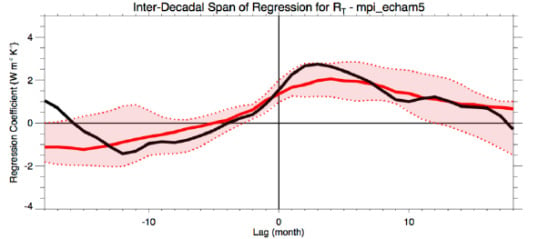Issues in Establishing Climate Sensitivity in Recent Studies

Acknowledgements
References
- Gregory, J.M.; Ingram, W.J.; Palmer, M.A.; Jones, G.S.; Stott, P.A.; Thorpe, R.B.; Lowe, J.A.; Johns, T.C.; Williams, K.D. A new method for diagnosing radiative forcing and climate sensitivity. Geophys. Res. Lett. 2004, 31, L03205. [Google Scholar] [CrossRef]
- Forster, P.M.F.; Gregory, J.M. The climate sensitivity and its components diagnosed from earth radiation budget data. J. Climate 2006, 19, 39–52. [Google Scholar] [CrossRef]
- Spencer, R.W.; Braswell, W.D. On the diagnosis of radiative feedback in the presence of unknown radiative forcing. J. Geophys. Res. 2010, 115, D16109. [Google Scholar] [CrossRef]
- Murphy, D.M.; Solomon, S.; Portmann, R.W.; Rosenlof, K.H.; Forster, P.M.; Wong, T. An observationally based energy balance for the earth since 1950. J. Geophys. Res. 2009, 114, D17107. [Google Scholar] [CrossRef]
- Clement, A.C.; Burgman, R.; Norris, J.R. Observational and model evidence for positive low-level cloud feedback. Science 2009, 325, 460–464. [Google Scholar] [CrossRef] [PubMed]
- Lindzen, R.S.; Choi, Y.-S. On the determination of climate feedbacks from erbe data. Geophys. Res. Lett. 2009, 36, L16705. [Google Scholar] [CrossRef]
- Lindzen, R.S.; Choi, Y.S. On the observational determination of climate sensitivity and its implications. Asia Pacific J. Atmos. Sci. 2011, 47, 377–390. [Google Scholar] [CrossRef]
- Spencer, R.W.; Braswell, W.D. On the misdiagnosis of surface temperature feedbacks from variations in earth’s radiant energy balance. Remote Sens. 2011, 3, 1603–1613. [Google Scholar] [CrossRef]
- Dessler, A.E. A determination of the cloud feedback from climate variations over the past decade. Science 2010, 330, 1523–1527. [Google Scholar] [CrossRef] [PubMed]
- Dessler, A.E. Cloud variations and the earth’s energy budget. Geophys. Res. Lett. 2011. [Google Scholar] [CrossRef]
- Murphy, D.M. Constraining climate sensitivity with linear fits to outgoing radiation. Geophys. Res. Lett. 2010, 37, L09704. [Google Scholar] [CrossRef]
- Chung, E.-S.; Soden, B.J.; Sohn, B.-J. Revisiting the determination of climate sensitivity from relationships between surface temperature and radiative fluxes. Geophys. Res. Lett. 2010, 37, L10703. [Google Scholar] [CrossRef]
- Trenberth, K.E.; Fasullo, J.T.; O'Dell, C.; Wong, T. Relationships between tropical sea surface temperature and top-of-atmosphere radiation. Geophys. Res. Lett. 2010, 37, L03702. [Google Scholar] [CrossRef]
- Trenberth, K.E. Changes in tropical clouds and radiation. Science 2002, 296, 2095. [Google Scholar] [CrossRef] [PubMed]
- Wong, T.; Wielicki, B.A.; Lee, R.B.; Smith, G.L.; Bush, K.A.; Willis, J.K. Reexamination of the observed decadal variability of the earth radiation budget using altitude-corrected erbe/erbs nonscanner wfov data. J. Climate 2006, 19, 4028–4040. [Google Scholar] [CrossRef]
- Fasullo, J.T.; Trenberth, K.E. The annual cycle of the energy budget. Part i: Global mean and land–ocean exchanges. J. Climate 2008, 21, 2297–2312. [Google Scholar] [CrossRef]
- Trenberth, K.E.; Fasullo, J.T.; Kiehl, J. Earth’s global energy budget. Bull. Amer. Meteor. Soc. 2009, 90, 311–324. [Google Scholar] [CrossRef]
- Trenberth, K. An imperative for climate change planning: Tracking earth's global energy. Current Opinion Environ. Sustain. 2009, 1, 19–27. [Google Scholar] [CrossRef]
- Trenberth, K.E.; Fasullo, J.T. Tracking earth’s energy. Science 2010, 328, 316–317. [Google Scholar] [CrossRef] [PubMed]
- Santer, B.D.; Mears, C.A.; Doutriaux, C.; Caldwell, P.M.; Gleckler, P.J.; Wigley, T.M.L.; Solomon, S.; Gillett, N.; Ivanova, D.P.; Karl, T.R.; et al. Separating signal and noise in atmospheric temperature changes: The importance of timescale. J. Geophys. Res. 2011. [Google Scholar] [CrossRef]
- Easterling, D.R.; Wehner, M.F. Is the climate warming or cooling? Geophys. Res. Lett. 2009, 36, L08706. [Google Scholar] [CrossRef]
- Palmer, M.D.; McNeall, D.J.; Dunstone, N.J. Importance of the deep ocean for estimating decadal changes in earth’s radiation balance. Geophys. Res. Lett. 2011, 38, L13707. [Google Scholar] [CrossRef]
- Katsman, C.A.; van Oldenborgh, G.J. Tracing the upper ocean’s “Missing heat”. Geophys. Res. Lett. 2011, 38, L14610. [Google Scholar] [CrossRef]
- Meehl, G.A.; Arblaster, J.; Fasullo, J.; Hu, A.; Trenberth, K. Model-based evidence of deep ocean heat uptake during surface temperature hiatus periods. Nature Climate Change 2011, 1. [Google Scholar] [CrossRef]
- NASA. CERES EBAF Data Sets. Available online: http://eosweb.larc.nasa.gov/PRODOCS/ceres/level4_ebaf_table.html (accessed on 8 September 2011).
© 2011 by the authors; licensee MDPI, Basel, Switzerland. This article is an open access article distributed under the terms and conditions of the Creative Commons Attribution license (http://creativecommons.org/licenses/by/3.0/).
Share and Cite
Trenberth, K.E.; Fasullo, J.T.; Abraham, J.P. Issues in Establishing Climate Sensitivity in Recent Studies. Remote Sens. 2011, 3, 2051-2056. https://doi.org/10.3390/rs3092051
Trenberth KE, Fasullo JT, Abraham JP. Issues in Establishing Climate Sensitivity in Recent Studies. Remote Sensing. 2011; 3(9):2051-2056. https://doi.org/10.3390/rs3092051
Chicago/Turabian StyleTrenberth, Kevin E., John T. Fasullo, and John P. Abraham. 2011. "Issues in Establishing Climate Sensitivity in Recent Studies" Remote Sensing 3, no. 9: 2051-2056. https://doi.org/10.3390/rs3092051
APA StyleTrenberth, K. E., Fasullo, J. T., & Abraham, J. P. (2011). Issues in Establishing Climate Sensitivity in Recent Studies. Remote Sensing, 3(9), 2051-2056. https://doi.org/10.3390/rs3092051






